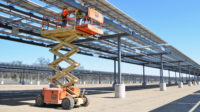The rate of new energy-related construction jobs last year outpaced and nearly doubled the rate of overall construction job growth, the U.S. Dept. of Energy found in its latest U.S. Energy and Employment Report. Construction was also one of the leading sources of that sector growth, following only utilities, said the update released Aug. 28.
More than half of about 250,000 new jobs created in the energy sector last year were tied to climate, clean energy and clean energy manufacturing, according to DOE. Construction jobs in the overall economy grew by 2.3%, outpacing general job growth at 2.1%—but within the energy sector, construction added nearly 90,000 jobs, a 4.5% increase.
DOE produces the U.S. Energy and Employment Report annually using Bureau of Labor Statistics data and a supplemental survey of energy sector employers.
About half of those new energy construction jobs were related to energy efficiency, which DOE counts as those tied to products that increase efficiency and those related to improved building performance. More than 34,000 new jobs were in construction of transmission, distribution and storage projects, and smaller amounts related to electric power generation and fuels.
Betony Jones, director of DOE’s Office of Energy Jobs, attributed the growth to legislation from the past several years, such as 2021’s Inflation Investment and Jobs Act and the Inflation Reduction Act in 2022, which both put money toward clean energy. “This is an engine driving job growth across the country,” she told reporters.
Unionization in clean energy reached 12.4%, outpacing the 11% rate for the overall energy sector, according to the report. Employers seeking full tax credits from the Inflation Reduction Act need to pay prevailing wage and draw a certain percentage of labor hours from apprenticeship programs. Working with unions can provide help for projects needing to "scale up fast and guarantee a steady stream of well-trained workers,” during labor shortages, David Turk, DOE deputy secretary, told reporters.
In addition to the construction jobs directly in energy, DOE also tracked for the first time construction jobs for projects in clean energy manufacturing and supply chain facilities. The report identified an additional 28,000 new construction jobs involved in building battery or solar module plants, offshore wind ports and warehouses storing clean energy products.
For “clean energy,” DOE counts anything related to technology enabling a transition to net-zero emissions, including renewables, nuclear, non-fossil storage, non-fossil transmission and distribution, non-fossil energy efficiency, biofuels and vehicles that do not require fossil fuels.
All the numbers in the report reflect growth last year.
This year’s numbers may differ, as various factors have led to some project owners scaling back or delaying work— including EV maker Rivian’s pause of plans to build a $5-billion plant in Georgia, Ford delaying completion of its second EV battery plant in Kentucky and Stellantis halting construction on part of its $37-billion EV battery plant with LG Energy Solution in Ontario, Canada.
Shifting market conditions have provided challenges for offshore wind developers, such as Orsted canceling two projects off the New Jersey coast last year. Legal challenges have also hampered some offshore work as well as interstate transmission line projects such as the $7-billion Grain Belt Express, which had approval of its Illinois portion overturned this month by a state appeals court.
But Jones said construction driven by the funding laws is expected to continue for decades. Demand for electricity is increasing from large users such as data centers, and DOE projects funded by the Inflation Reduction Act alone will double the share of power generation from clean sources by 2030 with growth in both solar and wind, she contended.
“We went through a long stretch in the United States where electricity demand was essentially flat,” White House climate advisor Ali Zaidi said. “We’re now hitting a growing trajectory on energy demand. We’ll be adding more capacity to the grid than we have in nearly two decades this year.”







